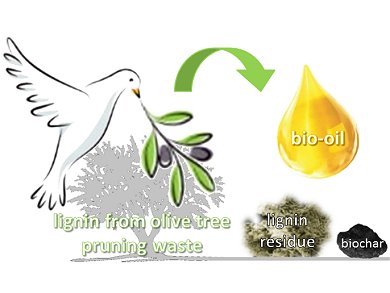Lignin from olive tree pruning waste is depolymerized by a mild microwave-assisted hydrogenolysis over a heterogeneous nickel catalyst, producing simple aromatics as “bio-oil”. Rafael Luque and co-workers, Universidad de Cordoba, Spain, describe how hydrogen-donating solvents are used, instead of hydrogen addition, with a nickel catalyst supported on a mesoporous aluminum silica support to produce bio-oil, biochar, and residual lignin. The use of formic acid, a potentially renewable solvent, even circumvents the production of biochar completely. The lignin itself is obtained from olive tree waste through the simple and benign organosolv method.
Avoiding the addition of hydrogen by in situ catalytic transfer hydrogenation is a boon, particularly as all protocols to-date requiring the hydrogen addition have a very poor hydrogen economy. The investigations, which used a series of hydrogen-donating solvents, showed the solvent to have a direct effect on the type of phenolic monomers yielded. The depolymerized products were analyzed by advanced spectrometric and chromatographic techniques to investigate the extent of the hydrogenolysis.
Optimization of this lignin hydrogenolysis approach is ongoing towards the goal of a fully sustainable and “green” lignin biorefinery concept.
- Heterogeneously Catalysed Mild Hydrogenolytic Depolymerisation of Lignin Under Microwave Irradiation with Hydrogen-Donating Solvents,
Ana Toledano, Luis Serrano, Jalel Labidi, Antonio Pineda, Alina Mariana Balu, Rafael Luque,
ChemCatChem 2013.
DOI: 10.1002/cctc.20120061
This article forms part of the ChemCatChem Special Issue on Functional Porous Materials.


